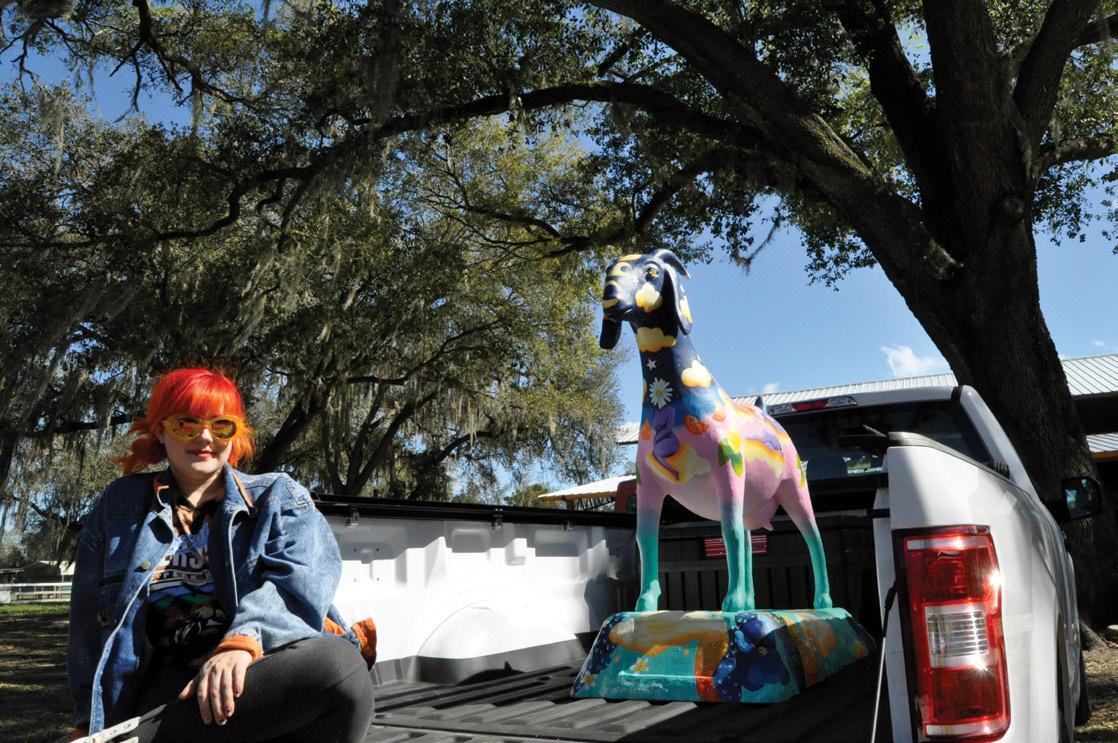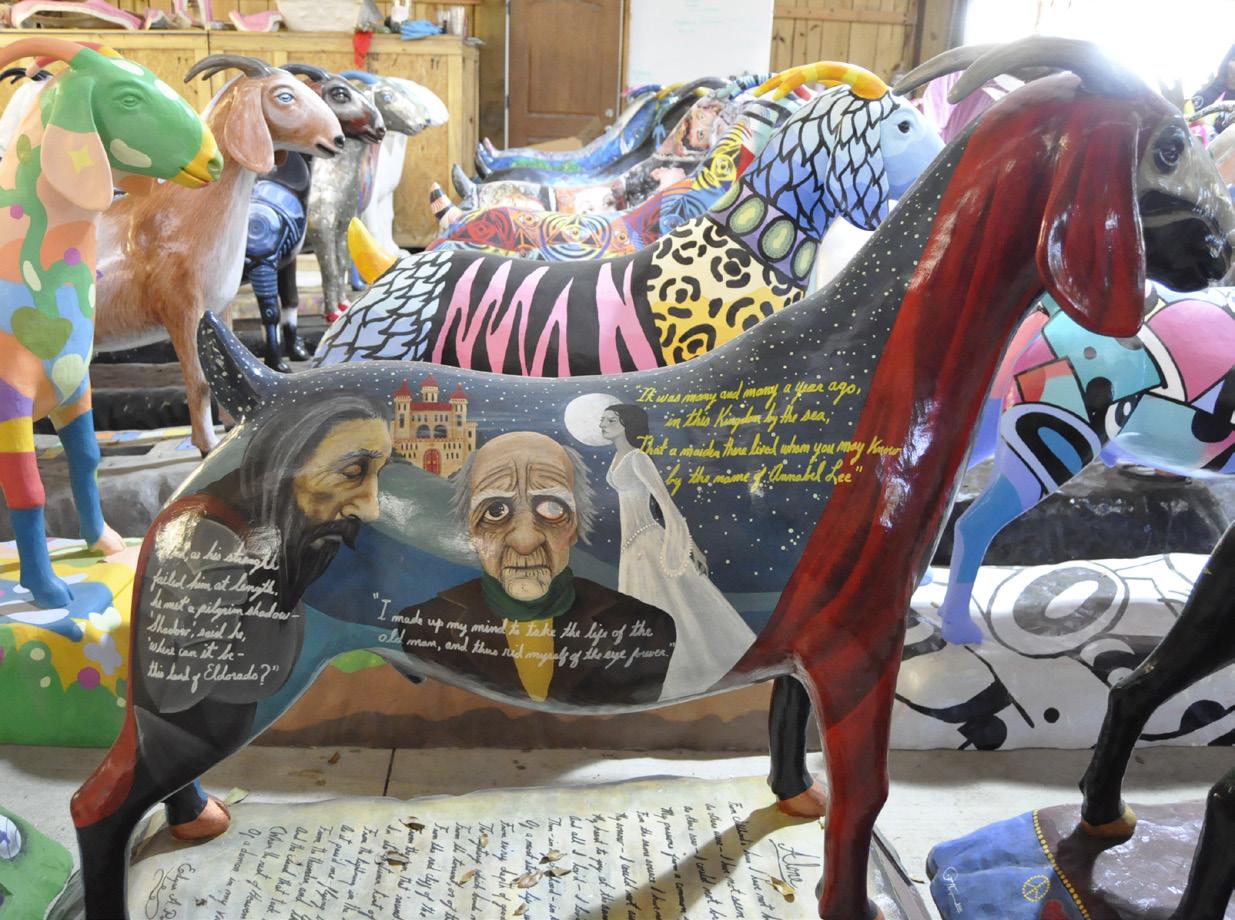
7 minute read
Project GOAT: Ready for Super Bowl LV
Rob Canton guards over his herd of painted and decorated goats as they await their debut at the Tampa Super Bowl.
A retired executive takes on the challenge of his life
Advertisement
PHOTOS AND STORY /MARCIA BIGGS

On a bright Sunday morning, Macy Higgins pulls up to the Grady Goat Farm in Thonotosassa with a painted goat in the bed of her pickup. The goat’s not real, mind you, but is a larger-than-life model that’s aiming to get in the barn with the other 45 or so painted goats—a “herd” soon to grow to 55. You can say she is looking for her tribe … and she has found it.
Nary a bleat echoes forth. These goats, all painted and adorned in anticipation of what appears to be a barnstorming costume party, silently await their destiny. Next February, they will be auctioned off during Super Bowl LV (55) in Tampa. Some 55 artists, mostly from across Tampa Bay, volunteered to paint these beauties, in support of Project GOAT and the fight against human trafficking. This hideous practice is the illegal transporting of people for purposes of forced labor or sexual exploitation.
The pop art goat of emerging artist Macy Higgins is dreamy and colorful in shades of pink and blue, covered in stars and cacti, fl oating citrus and clouds where female fi gures recline, they have daisies for faces. Every image has a meaning.
“I wanted my goat to focus on the young victims and survivors of sex trafficking,” she says. “She (the goat is female) is an oasis, a refuge. The clouds represent peace and dreams for the future, the daisies are innocence. The citrus means new life and freshness.” Higgins even added an udder in paper maché to make sure the goat was female.
The GOAT Project Begins
After 30 years in the corporate world (PricewaterhouseCoopers and Tampa Bay Lightning primarily), Rob Canton and his wife Debbie were ready for greener pastures. They moved out to Thonotosassa and started a goat farm. But they wanted to do something more than raise goats, they wanted to help the less fortunate, in particular disadvantaged children.
The Cantons created the Grady Goat Foundation named after a young blind and deaf goat on the farm, and with Debbie by his side, started raising funds for various charities. They purchased a van to transport their critters to places like the Ronald McDonald House where kids got to be with kids. Rob had heard about goat yoga and he and Debbie decided to give it a try. Despite the location, they now get people from across the state cows and down-dogs with goats every every weekend. Social distancing is practiced so classes fill quickly.
Around November of 2018, Rob got the idea for a goat-focused public art project for charity, but Project GOAT itself, which stands for Global Offensive Against Trafficking, wasn’t formalized until March of 2019.
“I read a blog post by Bill Gates about how goats are empowering women in the poorest parts of India,” he said. “India is known as a top location in the world for human traffi cking, mainly labor but sex traffi cking, as well. Goats

Artist Macy Higgins drops off her goat at the farm.
there give these otherwise destitute women and their families a means to make a living through goat products like meat, cheese and milk, and also careers as caretakers for the 150 million goats living in that country. I had an epiphany. I wanted to combine our love for goats and the arts to spread awareness about this terrible crime taking place across the globe.”
Canton had seen the attention given who come to the farm to do cats, to painted dolphins, manatees, pigs and elephants in other cities, so why not goats, he thought. He started making calls and he and Debbie raised $100,000 in funding through Grady Goat Foundation’s charity goat yoga classes to get the project off the ground. He commissioned artist Scott Joseph Moore of Moore Art Expressions in St. Petersburg to design and cast the 80-pound sculptures on bases.
Once word got out in his circle of friends and business associates, the calls started coming in. Rob invited both prominent and emerging artists across Tampa Bay to paint goats. He was blown away by the response.
Goats of a Diff erent Color
The goats are as varied as the 55 artists who painted them. Some are hauntingly surreal with messages of human bondage; others are colorful and gay. There are biker goats, pirate goats, a New York Yankees goat and even a Jimmy Buff et goat. Top artists include nationally renowned St. Pete muralists BASK and Bekky Beukes, metal artist Frank Strunk III, and even architect Yann Weymouth. Yes, that Yann Weymouth who designed the Dali Museum and the James Museum of Western & Wildlife Art.

Renowned architect and St. Pete resident Yann Weymouth contributed a goat.

Above, artist Dee Perconti’s goat represents trafficked children and Rapha House.
Project GOAT is particularly meaningful to St. Pete multimedia artist Dee Perconti. She is on the board of Rapha International, a nonprofi t committed to ending the traffi cking and sexual exploitation of children. The organization, based in Joplin, MO, rescues and rehabilitates children in Cambodia, Thailand and Haiti by building and operating safe houses and providing schooling, counseling and skills training for children who have lost their childhood.
When Rob Canton heard of her mission, he contacted Perconti about painting a goat for exploited children. She jumped at the chance. “My goat’s name is Rapha, which means ‘healing’ and is fi lled with meaning,” she said. “I wanted to show how young these children are and to put faces to this horrifi c crime.” The base is covered in photos of actual trafficked children.
South African artist Bekky Beukes is in demand around the world for her murals and paintings of ethereal female figures. Now living in Tampa Bay, Beukes said she felt privileged to be invited to paint for Canton’s cause and her own – female empowerment. She dived into researching her subject through news articles. Her goat focuses on the missing and murdered indigenous women in North America.
“I was impacted by the sorrow of those left behind,” she relates. “It’s not only the Native American women that suff er, the fathers, brothers and sons shared accounts of their torment and madness … the pain of this injustice belongs to us all.”
Her goat is covered in traditional symbols representing Native American culture. “Every symbol has a meaning and these symbols expose the heart of this nation. I believe education can be a very unifying force, it allows us to witness ourselves in others, despite our differences.”

Artist Bekky Beukes and her goat below with Native American symbolism

Goats on the Go
The last weekend in February, the painted goats made their offi cial debut at the Gasparilla Festival of the Arts in downtown Tampa. They will be making three or four appearances in Tampa and St. Pete during the year leading up to Super Bowl LV in February 2021, says Canton, including during St. Pete’s Shine Mural Festival in October.
If things work out as planned, Canton’s going to take the goats on the road, so to speak. The 2022 Super Bowl LVI in Los Angeles might be just the ticket to share the Project GOAT message again—this time with 56 goats. “Why the Super Bowl?” Rob asks. “It’s an event that creates demand for human traffi cking. This happens at other major events like the Daytona 500, Kentucky Derby, Consumer Electronics Show in Vegas and so many others, but the Super Bowl is the biggest and just so happens to be coming to Tampa Bay in less than a year.”
Says Dee Perconti of Rapha International: “This just gives me hope. Because sometimes things seem insurmountable, but it’s true that one person can start a fi re.” To keep up with the latest news on Project GOAT, check out peacelovegoats.org
Sponsor a Goat
Canton has already gained significant support from organizations and individuals like Candy DeBartolo (wife of former San Francisco 49ers owner Eddie DeBartolo Jr.), Epicurean Hotel, Reeves Import Motor Cars, Famous Tate Appliance & Bedding Centers, Sun Toyota Collision Center and Yann & Susana Weymouth. Sponsoring a goat (which ranges from $5,000 to $10,000 each) allows you to display that goat in your place of business or other location throughout 2020, and your sponsorship dollars are also credited towards the final auction price. Information on Project GOAT, sponsorships, and other details may be found at www.peacelovegoats.org.











